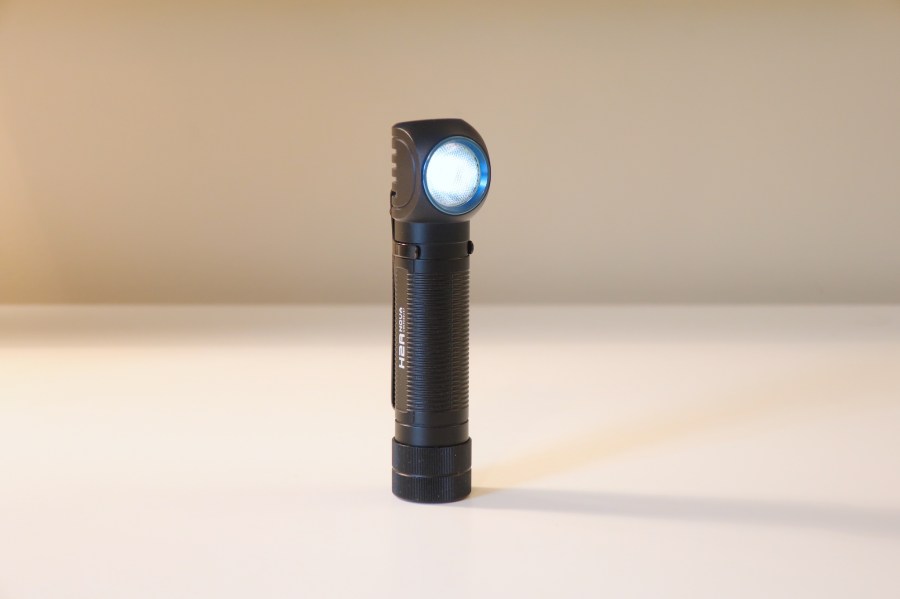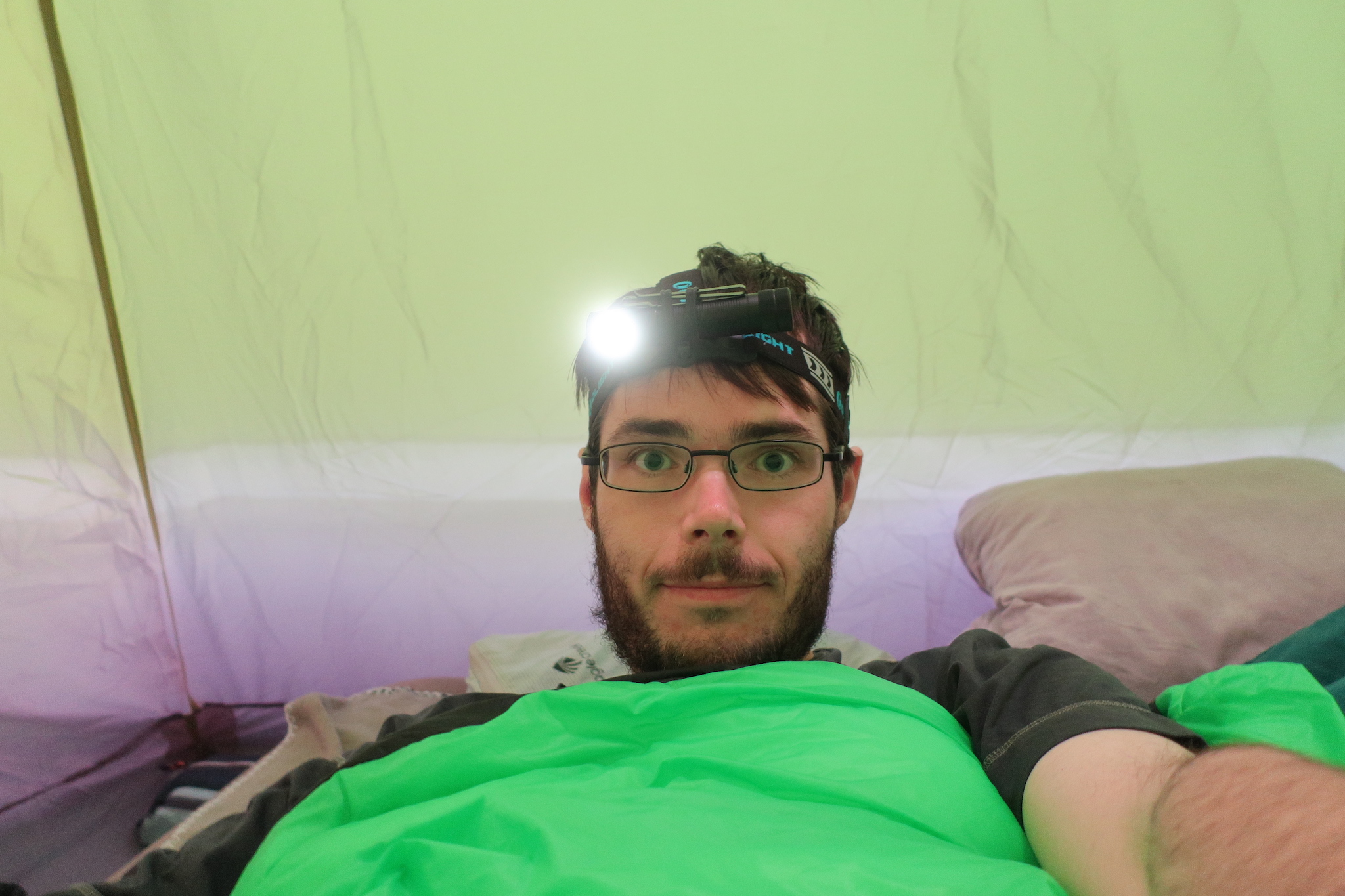Alex Roddie reviews a torch bright enough to guide Hobbits through the Mines of Moria
Important update: if not used with care, we found that this torch carries a risk of overheating. In turbo mode it can get hot enough to melt through tent fabric or clothing, or possibly even pose a fire risk. Similar reports are also coming in. In light of this overheating risk, we’ve reduced the star rating from 4 to 3. The rest of the review is unchanged.
This is a seriously bright torch.
Although technology has improved a lot since the advent of LED head lamps, most torches still fall into one of two categories: lightweight and not particularly bright, or heavier and brighter. The H2R Nova from Olight succeeds in being both quite light and extremely bright. But is it the torch you’d reach for when heading out for an overnighter on the hill?
The H2R Nova is a modular hand/head torch with a claimed maximum brightness of 2,300 lumens (resulting in a 153m beam range). Quoted battery life varies between 45 days on its lowest setting (1-lumen ‘moonlight’ mode) and only an hour or two on maximum turbo mode. At the settings most likely to be used (30 and 150 lumens) quoted battery life extends from a reasonable 50 to 10 hours. The battery used is a proprietary 3.6V, 3,000mAh 18650 rechargeable Li-Ion battery – sorry, no option of shoving in a couple of AAs in a pinch.
Total weight on our scale is 179g; the torch itself weighs 54g, the battery 48g, head strap 68g, and the pocket clip 8g. It comes with a proprietary USB charging cable that attaches magnetically to the charging port on the base of the torch. The modular nature of the system makes it highly versatile, although it’s arguable there are better options if you’re looking for a mountain head torch.
First impressions
The lamp itself is a small hand torch with a right-angled lens. The metal chassis has plenty of grip, making it easy to hold, and the precision-machined aluminium feels very well-made. It’s also waterproof to IPX8 standard (2m immersion) and drop-tested to 1.5m.
The base of the lamp is flat and magnetised. This is where you’ll find the charging port (the contacts are exposed, a little disconcertingly, and there’s a ‘do not short circuit’ warning).
The head strap is clever – it may look like a standard cradle with adjustable elastic loops running around the head and over the crown, but it docks magnetically with the lamp. The magnetic seal is good enough to hold the lamp in place when you aren’t moving, but there’s also a rubber strap that latches in place, holding it more securely. This fits even when the metal pocket clip is attached to the lamp.
The pocket clip is reversible and detachable. I think it’s best left in place, because it opens up the possibility of attaching the lamp to your belt, rucksack strap, or cap brim. Depth perception when walking at night can be improved by using a lower light source, so this is a welcome option – and one that few head torches offer.
The torch charges quickly from any USB source. A nice touch is that the charging cable has an indicator LED: red indicates charging, green indicates charging complete. It gets somewhat warm when charging. As a backpacker, I’d have preferred a standard Micro USB charging cable – having to carry a separate, proprietary cable that works with nothing else in my pack is a nuisance.
In use
The name of the game here is versatility. This torch is not the best at any one job, but it can do everything competently.
As a hand-held torch, the right-angle format is useful because you can easily clip the torch to your belt, or a rucksack strap, and the beam will aim forward. It also means you can stand the torch on a desk for illumination at close range. The strong magnet in the base opens up more possibilities – it’s easily powerful enough to support the torch stuck to the side of a car, for example.
It’s worth mentioning that the magnets in both the lamp and the strap can be a hindrance as well as a help. I did not feel comfortable storing the torch in the same dry bag as my compass.
There is a single, large button on the top. The user interface is simple:
- Click once to turn on (remembers previous setting), once again to turn off;
- When on, a one-second press cycles through the three main brightness modes;
- When off, a one-second press cycles between ultra-low 1-lumen mode and the standard modes;
- At any point, double-press the switch to enter turbo mode;
- Triple-click the switch to access an SOS mode;
- Lock or unlock the torch by pressing and holding the button for two seconds.
Being able to quickly access turbo mode with a double tap is useful, but turbo mode is insane. It’s brighter than any torch I’ve ever used, and can floodlight everything at short, medium and even long range. In a darkened room it’s like full noon daylight. Be warned, though: the lamp quickly gets very hot when in turbo mode, and it has a catastrophic effect on battery life. The lamp automatically throttles down to a lower brightness when it gets too hot. Needless to say, turbo mode is for very short bursts only (for example if you’re Gandalf, leading Hobbits through the Mines of Moria, and think it’s “time for a little real light”).
How hot can it get? Hot enough to really notice. I’ve heard reports of others damaging tents or clothing while leaving the torch on turbo mode, so it’s important to be careful – and there is no warning of an overheating risk on the packaging.
In reality, most people will rarely if ever need this kind of brightness. I found the 30-lumen ‘low’ setting the most useful for camp use, while 150 lumens is plenty for night walking. The 1-lumen moonlight setting is useful for reading at close quarters in your sleeping bag but is too dim for most other applications.
As a head torch, the H2R Nova is competent but not exceptional. The overall weight does creep up when you add in the magnetic head band as well, and it feels a bit front-heavy, but on the plus side it’s easy to rotate the lamp’s angle and the switch is within easy reach. It certainly does the job as a mountain head torch, although the fact that it can’t accept standard batteries is a downside. In winter, or at any time of year when you expect to be walking at night, you might want to carry a spare lamp just in case. You certainly won’t want to stop to charge this lamp if it runs out of juice.
Battery life is very respectable on the lower settings, and I found the claim of 50 hours at 30 lumens to be roughly accurate. At 150 lumens I didn’t quite achieve the stated 10 hours, but on a full charge this is still quite acceptable to get you off the hill at most times of year.
The set-and-forget SOS mode is a nice addition. I didn’t need to use it – thankfully! – although it could be a real benefit in the event of an emergency.
The proprietary charging cable is annoying because if you lose it (or it breaks) you can’t charge the torch, and good luck finding a replacement battery anywhere but online! This could be a deal-breaker when hiking a long-distance trail, for example.
Who is this torch for?
The H2R Nova is a capable all-rounder, but I don’t think it’ll be the first choice for backpackers and hillwalkers. There are lighter options with more useful battery and/or charging setups (for example, lamps that can both charge rechargeable cells internally over Micro USB, and take standard AAA cells if required). On the other hand, such competitors are rarely this bright – and not always this well-made either.
I think the H2R Nova makes a great supplementary or backup lamp. It really shines (get it?) when used as a hand torch. It’s great clipped to a belt or rucksack strap, and can be used to provide an intense punch of illumination when required. Its rugged and waterproof construction make it great for the British mountains. I’d be very happy carrying the H2R Nova into the winter mountains as a sidekick to another head torch, but, for most walkers, it doesn’t quite add up as the best choice for your main lamp.
Other notable downsides include the risk of overheating, and the strong magnets that could affect your compass. These may not be big downsides for you, but they’re worth being aware of.













